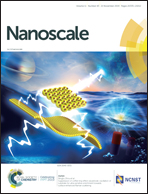Highly efficient broadband photodetectors based on lithography-free Au/Bi2O2Se/Au heterostructures†
Abstract
As one of the bismuth-based oxychalcogenide materials, Bi2O2Se ultrathin films have received intense research interest due to their high carrier mobility, narrow bandgaps, ultrafast intrinsic photoresponse and long-term ambient stability; they exhibit great potential in electronic and optoelectronic applications. However, the device performance of photodetectors based on metal/Bi2O2Se/metal structures has degraded due to the undesirable defects or contaminants from the electrode deposition or the sample transfer processes. In this work, highly efficient photodetectors based on Au/Bi2O2Se junctions were achieved with Au electrodes transferred under the assistance of a probe tip to avoid contaminants from traditional lighography methods. Furthermore, to improve the charge transfer efficiency, specifically by increasing the intensity of the electrical field at the Au/Bi2O2Se interface and along the Bi2O2Se channels, the device annealing temperature was optimized to narrow the van der Waals gap at the Au/Bi2O2Se interface and the device channel length was shortened to improve the overall device performance. Among all the devices, the maximum device photoresponsivity was 9.1 A W−1, and the device response time could approach 36 μs; moreover, the photodetectors featured broadband spectral responses from 360 nm to 1090 nm.



 Please wait while we load your content...
Please wait while we load your content...